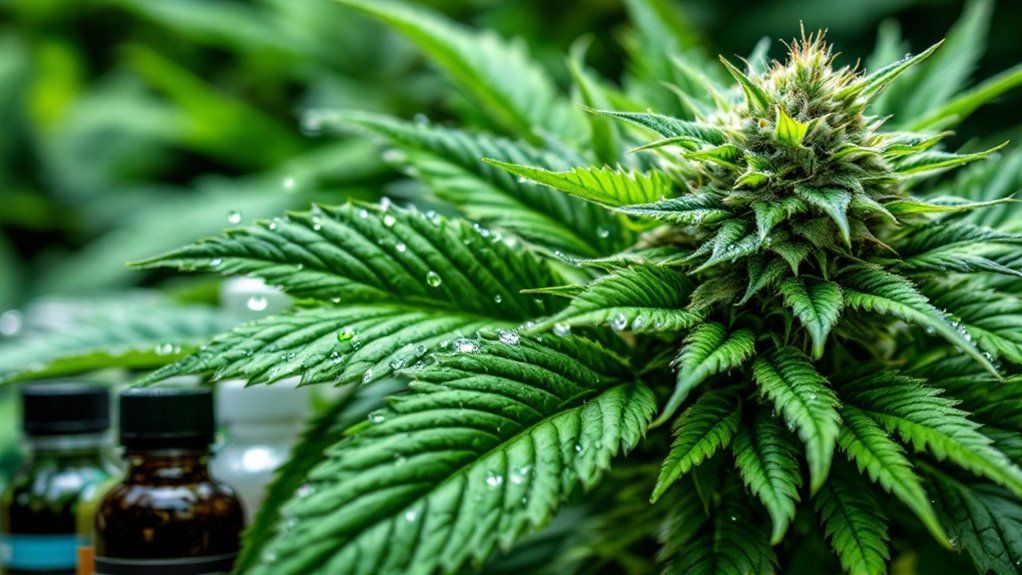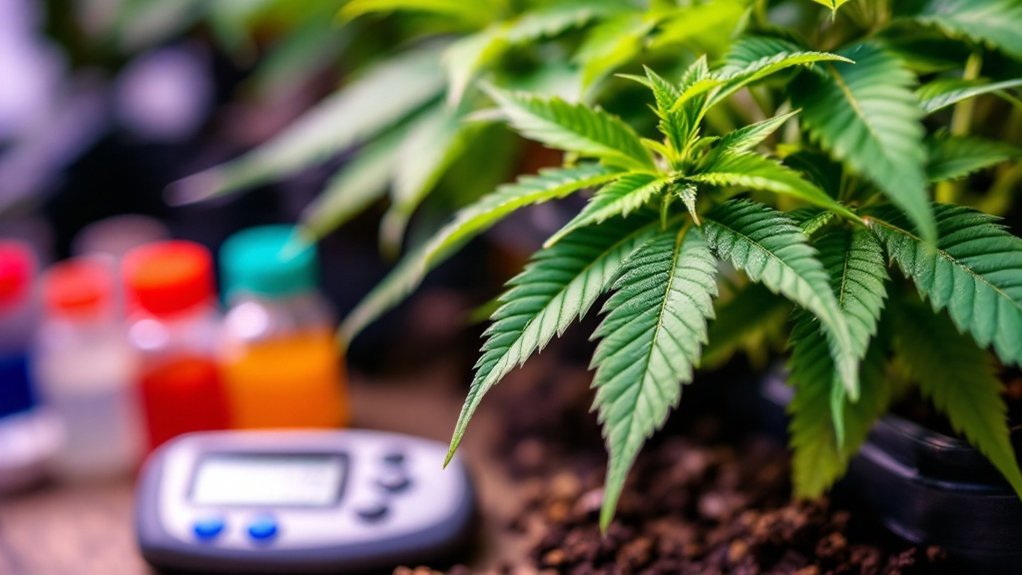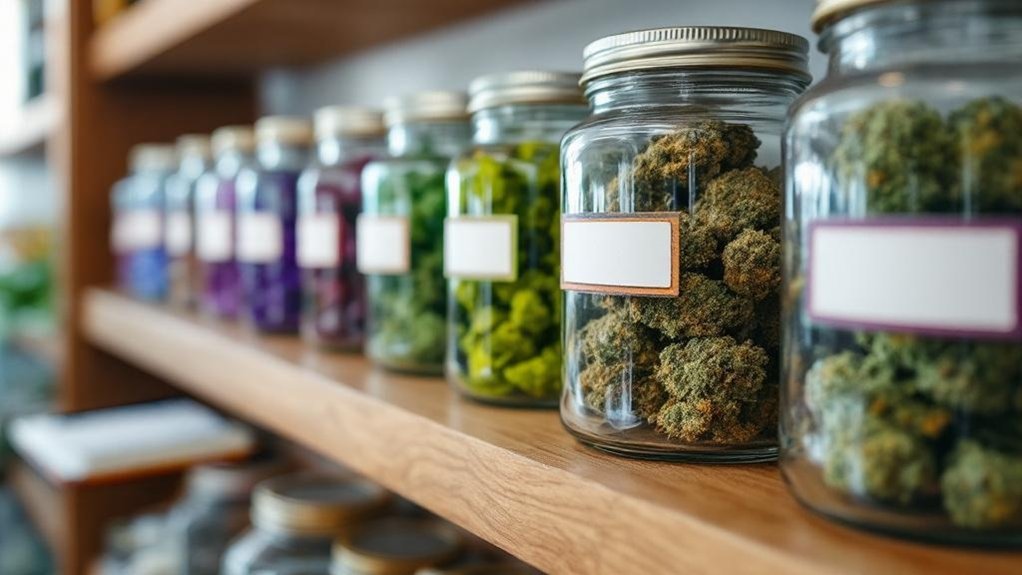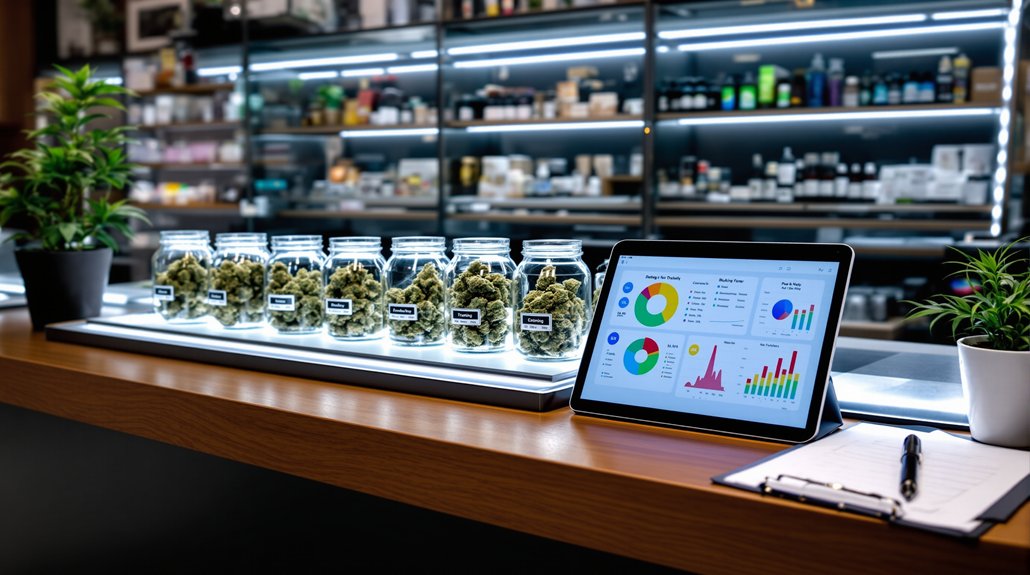Cannabis requires micronutrients in small but critical amounts for ideal growth and development. Iron, zinc, and manganese support chlorophyll production, hormone regulation, and photosynthesis, while boron, copper, molybdenum, and chlorine facilitate cell wall formation, nitrogen metabolism, and osmotic balance. Deficiencies typically manifest as chlorosis, stunted growth, or twisted leaves, requiring pH adjustments for proper absorption. Understanding these essential elements enables growers to prevent common problems before they impact plant health and yield.

The intricate balance of micronutrients forms the foundation for successful cannabis cultivation, though these elements are required in much smaller quantities than macronutrients like nitrogen, phosphorus, and potassium. Despite their minimal presence, these trace elements play critical roles in plant metabolism, enzyme function, and overall health. Understanding how iron, zinc, manganese, boron, copper, molybdenum, and chlorine contribute to cannabis development enables growers to diagnose deficiencies and enhance plant nutrition throughout the growth cycle.
Iron serves as a crucial component in chlorophyll synthesis, directly impacting photosynthetic efficiency and energy transfer within cannabis plants. When iron becomes deficient, interveinal chlorosis appears as yellowing between leaf veins, particularly in younger growth. This micronutrient remains essential throughout the plant’s life cycle but holds particular significance during vegetative growth. Excessive iron application can prove counterproductive, potentially inducing toxicity and blocking uptake of other crucial micronutrients.
Iron fuels photosynthesis in cannabis, yet requires precise management to prevent yellowing leaves and nutrient blockages.
Zinc and manganese work in complementary roles, with zinc promoting hormone production and internodal extension while manganese participates in photosynthesis and carbohydrate metabolism. Micronutrients exist in either cationic or anionic forms that determine how they’re absorbed by the plant roots. Deficiencies in these elements manifest as stunted growth with leaf distortion for zinc, and yellow spotting with potential necrosis for manganese. Both elements require careful balance, as excesses can disrupt the absorption of other nutrients.
Boron facilitates cell wall formation and nutrient translocation throughout cannabis plants. Its deficiency results in brittle stems and compromised root development, while copper deficiency appears as twisted or bluish leaves due to impaired chlorophyll production. Both elements require precise management, as their narrow ideal range means excesses can quickly lead to toxicity symptoms.
Molybdenum plays a specialized role in nitrogen metabolism, helping convert nitrates into amino acids essential for protein synthesis. Its deficiency often mimics nitrogen deficiency with pale foliage. While rarely deficient in neutral soils, acidic growing media may require supplementation.
Chlorine, though seldom discussed, regulates osmosis and ionic balance while supporting stomatal function. Its deficiency rarely occurs in most growing environments, but excess chlorine from poor-quality water can disrupt nutrient uptake. Maintaining the proper soil pH range is critical for ensuring these micronutrients remain available to cannabis plants throughout their development.
Cannabis cultivators who maintain appropriate micronutrient levels throughout the plant’s life cycle create ideal conditions for robust growth, vigorous flowering, and maximum yield potential. The complex interplay between these trace elements underscores the importance of balanced nutrition in successful cannabis production.
Frequently Asked Questions
How Does Micronutrient Deficiency Affect Cannabis Terpene Production?
Micronutrient deficiency greatly impairs cannabis terpene production by disrupting essential biosynthetic pathways.
Zinc and boron shortages particularly affect terpene synthesis, resulting in reduced aromatic profiles and diminished potency.
Iron deficiency limits the energy available for secondary metabolite production, while manganese shortage suppresses specific terpene outputs.
The chemical consequences include altered terpene profiles, decreased compound complexity, and compromised overall flower quality.
Some deficiencies may paradoxically increase certain terpenoids as a stress response, though at the expense of plant health.
Can I Use Human Vitamin Supplements for Cannabis Micronutrients?
Using human vitamin supplements for cannabis is not recommended.
These products are formulated for human consumption, not plant nutrition, and contain incorrect ratios of nutrients for cannabis physiology. Human supplements may introduce contaminants harmful to plants and consumers, while lacking essential plant micronutrients in bioavailable forms.
Additionally, human supplements aren’t regulated for agricultural use, potentially violating cultivation regulations.
Commercial cannabis-specific nutrients are formulated to address the plant’s unique micronutrient requirements while meeting agricultural safety standards.
Are Foliar Sprays Better Than Soil Amendments for Micronutrient Delivery?
Foliar sprays provide immediate micronutrient access through leaf absorption, making them superior for correcting acute deficiencies.
Soil amendments offer sustained nutrient release and promote long-term soil health but work more slowly.
Neither method is universally “better”; rather, they serve complementary purposes.
Foliar applications excel in urgent situations and when soil conditions limit uptake, while soil amendments establish the foundation for ongoing plant nutrition.
The most effective approach often combines both methods strategically.
Which Micronutrients Enhance Cannabis’s Resistance to Pests Naturally?
Silicon (silica) greatly enhances cannabis’s natural pest resistance by strengthening cell walls, creating physical barriers against insects and pathogens.
Zinc activates defense enzymes and contributes to toxin neutralization.
Manganese supports the production of lignin and phenolic compounds that deter pests.
Iron facilitates chlorophyll production, strengthening overall plant health and resilience.
Copper helps synthesize defense compounds and activates enzymes involved in resistance pathways, particularly against fungal pathogens.
Do Hydroponic Systems Require Different Micronutrient Ratios Than Soil?
Hydroponic systems indeed require different micronutrient ratios than soil cultivation.
In hydroponics, plants rely exclusively on the nutrient solution, necessitating precise, often higher concentrations of chelated micronutrients for immediate uptake.
Soil systems contain natural reserves and microbial activity that facilitate gradual nutrient release.
The pH requirements also differ greatly: hydroponics functions best at 5.5-6.0, while soil systems perform better at 6.0-7.0.
Hydroponic growers must monitor and adjust micronutrient levels more frequently to prevent rapid deficiencies or toxicities that soil naturally buffers.









